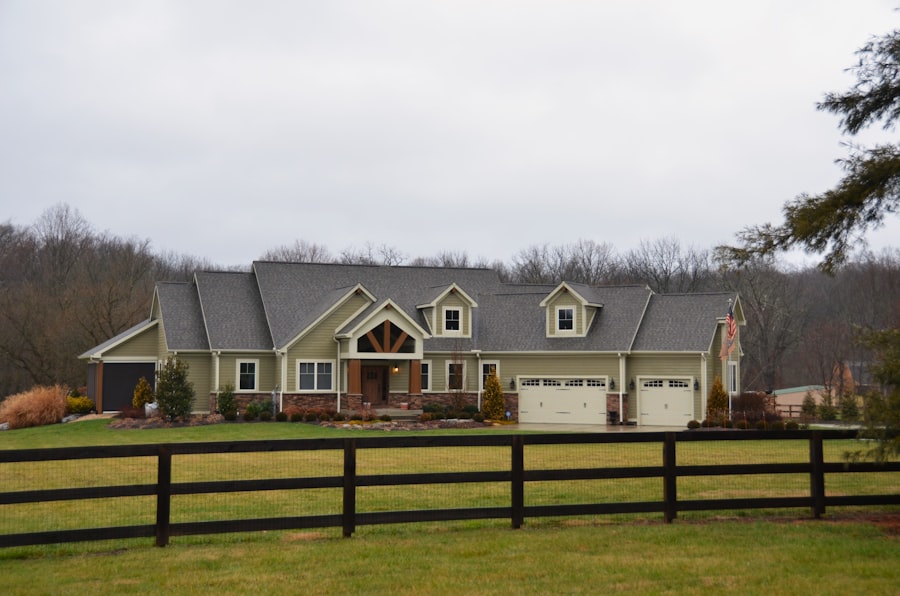In the digital age, a well-designed website is not just an accessory for real estate professionals; it is a fundamental tool that can significantly influence the success of their business. The real estate market is highly competitive, and potential buyers and sellers often begin their journey online. A website serves as the first point of contact for many clients, making it essential to create a strong first impression.
A thoughtfully designed real estate website can convey professionalism, trustworthiness, and expertise, which are crucial in establishing a solid relationship with clients. Moreover, effective web design goes beyond aesthetics; it encompasses functionality and user experience. A website that is visually appealing but difficult to navigate can frustrate users and drive them away.
Conversely, a well-structured site that prioritizes user experience can enhance engagement, encourage exploration, and ultimately lead to conversions. In essence, real estate web design is a blend of art and science, where visual elements must harmonize with practical features to create an engaging platform that meets the needs of both buyers and sellers.
Key Takeaways
- Real estate web design is crucial for attracting and retaining potential buyers and sellers.
- High-quality images and videos are essential for showcasing properties effectively on a real estate website.
- User-friendly navigation and search features are key elements for a successful real estate website.
- Mobile responsiveness is important for catering to on-the-go buyers who use their smartphones for property searches.
- Compelling calls-to-action and social proof help in lead generation and building credibility for a real estate website.
Identifying Key Elements for a Successful Real Estate Website
Clear and Intuitive Layout
A well-designed website should have a clear and intuitive layout that allows visitors to find information quickly and easily. This includes having well-defined sections for property listings, agent profiles, and resources for buyers and sellers. A cluttered or confusing layout can deter potential clients from exploring further, so simplicity and clarity should be prioritized.
Advanced Search Functionalities
The integration of advanced search functionalities is another critical element of a successful real estate website. Users should be able to filter properties based on various criteria such as location, price range, number of bedrooms, and property type. This capability not only enhances user experience but also increases the likelihood of users finding properties that meet their specific needs.
Personalized User Experience
Incorporating features like saved searches or property alerts can further engage users by providing them with personalized experiences tailored to their preferences. This not only enhances user satisfaction but also increases the chances of converting visitors into clients.
Utilizing High-Quality Images and Videos to Showcase Properties
In real estate, visuals play a pivotal role in attracting potential buyers. High-quality images and videos can significantly enhance the appeal of property listings, allowing prospective clients to visualize themselves in the space. Professional photography that captures the essence of a property can make a substantial difference in how it is perceived online.
For instance, images that highlight natural light, spacious layouts, and unique architectural features can create an emotional connection with viewers, prompting them to take the next step in their home-buying journey. Moreover, incorporating video tours can elevate the user experience even further. Virtual walkthroughs allow potential buyers to explore properties from the comfort of their homes, providing a more immersive experience than static images alone.
This is particularly beneficial in today’s fast-paced environment where many buyers prefer to conduct initial property searches online before scheduling in-person visits. By utilizing high-quality visuals and engaging video content, real estate websites can effectively showcase properties and capture the attention of prospective clients.
Implementing User-Friendly Navigation and Search Features
User-friendly navigation is a cornerstone of effective web design, especially in the real estate sector where users often seek specific information quickly. A well-organized menu structure that categorizes properties by type, location, or price range can streamline the browsing experience. Additionally, incorporating breadcrumb navigation allows users to track their path through the site easily, making it simpler to return to previous pages without feeling lost.
Search features should also be robust and intuitive. Implementing an advanced search bar that allows users to input various criteria can significantly enhance usability. For example, allowing users to search by neighborhood or school district can help them find properties that align with their lifestyle preferences.
Furthermore, including filters for amenities such as swimming pools or garages can cater to specific buyer needs. By prioritizing user-friendly navigation and search capabilities, real estate websites can ensure that visitors have a seamless experience while exploring available listings.
Incorporating Mobile Responsiveness for On-the-Go Buyers
With an increasing number of consumers using mobile devices to browse properties, ensuring that a real estate website is mobile-responsive is no longer optional; it is essential. A mobile-responsive design adapts seamlessly to different screen sizes and resolutions, providing an optimal viewing experience whether users are on a smartphone or tablet. This adaptability not only enhances user satisfaction but also improves search engine rankings since search engines like Google prioritize mobile-friendly sites in their results.
Mobile responsiveness also allows for features such as click-to-call buttons or location-based services that can be particularly useful for on-the-go buyers. For instance, a potential buyer driving through a neighborhood may want to quickly access property listings nearby or contact an agent directly from their mobile device. By incorporating mobile responsiveness into web design, real estate professionals can cater to the needs of modern consumers who expect convenience and accessibility at their fingertips.
Creating Compelling Calls-to-Action for Lead Generation
Calls-to-action (CTAs) are critical components of any successful real estate website as they guide users toward taking specific actions that can lead to conversions. Effective CTAs should be strategically placed throughout the site to encourage visitors to engage further with the content or services offered. For example, buttons prompting users to “Schedule a Viewing,” “Request More Information,” or “Sign Up for Property Alerts” can effectively capture leads by inviting users to take the next step in their home-buying journey.
The language used in CTAs should be clear and compelling, creating a sense of urgency or excitement about the opportunity being presented. Phrases like “Don’t miss out on your dream home!” or “Get exclusive access to new listings!” can motivate users to act quickly rather than delaying their decision-making process. By crafting persuasive CTAs and placing them strategically throughout the website, real estate professionals can enhance lead generation efforts and convert casual visitors into potential clients.
Integrating Social Proof and Testimonials for Credibility
In an industry where trust is paramount, integrating social proof and testimonials into a real estate website can significantly enhance credibility and foster confidence among potential clients. Positive reviews from past clients serve as powerful endorsements that can influence prospective buyers’ decisions. Displaying testimonials prominently on the homepage or dedicated testimonial pages allows visitors to see firsthand accounts of successful transactions and satisfied customers.
Additionally, incorporating social media links or showcasing active social media feeds can further bolster credibility by demonstrating an agent’s engagement with the community and current market trends. For instance, sharing success stories or client experiences on platforms like Instagram or Facebook can create a sense of authenticity that resonates with potential clients. By leveraging social proof effectively, real estate websites can build trust and establish themselves as reliable sources in a competitive market.
Optimizing for Search Engines to Increase Visibility
Search engine optimization (SEO) is a critical aspect of web design that cannot be overlooked when creating a real estate website. Optimizing content for search engines helps increase visibility in search results, making it easier for potential clients to find listings and services online. This involves using relevant keywords throughout the site’s content, including property descriptions, blog posts, and meta tags.
In addition to keyword optimization, local SEO strategies are particularly important for real estate websites since most buyers are searching for properties within specific geographic areas. This includes creating location-specific landing pages that highlight available listings in particular neighborhoods or cities. Furthermore, ensuring that the website loads quickly and is mobile-friendly contributes positively to SEO rankings.
By implementing effective SEO strategies, real estate professionals can enhance their online presence and attract more organic traffic to their websites.
Providing Valuable Content and Resources for Buyers and Sellers
A successful real estate website goes beyond merely listing properties; it serves as a valuable resource for both buyers and sellers by providing informative content that addresses their needs and concerns. This could include blog posts about market trends, guides on the home-buying process, tips for staging homes for sale, or insights into local neighborhoods. By offering valuable content, real estate professionals position themselves as knowledgeable experts in their field.
Additionally, providing downloadable resources such as checklists for first-time homebuyers or market analysis reports can further engage visitors while capturing leads through email sign-ups. Educational webinars or video tutorials on topics like financing options or home inspections can also add value to the user experience. By prioritizing valuable content creation, real estate websites can establish authority in the industry while fostering relationships with potential clients.
Personalizing the User Experience with Customization Options
Personalization is becoming increasingly important in web design as consumers seek tailored experiences that cater to their individual preferences. Real estate websites can enhance user engagement by offering customization options that allow visitors to filter property listings based on their specific criteria or save favorite properties for future reference. This level of personalization not only improves user satisfaction but also encourages repeat visits as users return to explore new listings that match their interests.
Furthermore, implementing features such as personalized property recommendations based on user behavior or preferences can create a more engaging experience. For instance, if a user frequently searches for homes with certain amenities or in specific neighborhoods, suggesting similar properties can streamline their search process. By focusing on personalization within the user experience, real estate websites can foster deeper connections with potential clients while increasing the likelihood of conversions.
Monitoring and Analyzing Website Performance for Continuous Improvement
The digital landscape is ever-evolving, making it essential for real estate professionals to continuously monitor and analyze their website’s performance. Utilizing tools like Google Analytics allows agents to track key metrics such as visitor behavior, page views, bounce rates, and conversion rates. By understanding how users interact with the site, professionals can identify areas for improvement and make data-driven decisions regarding design changes or content updates.
Regularly assessing website performance also enables real estate agents to stay ahead of industry trends and adapt their strategies accordingly. For example, if analytics reveal that certain property types are generating more interest than others, agents may choose to focus their marketing efforts on those listings or create targeted content around them. By committing to ongoing analysis and improvement based on user data, real estate websites can remain competitive while effectively meeting the evolving needs of their audience.
If you are looking to improve your real estate website design, you may want to check out this article on uprankerz.com. This website offers valuable insights and tips on how to create a visually appealing and user-friendly website for your real estate business. Additionally, you can also read their article on hello-world for more information on web design strategies that can help you stand out in the competitive real estate market.
FAQs
What is real estate web design?
Real estate web design refers to the process of creating and designing websites specifically for real estate professionals, agencies, and companies. These websites are tailored to showcase property listings, provide information about the real estate services offered, and attract potential clients.
What are the key elements of a real estate web design?
Key elements of a real estate web design include a user-friendly property search function, high-quality property images and videos, detailed property descriptions, contact forms, interactive maps, and mobile responsiveness. Additionally, branding elements and calls-to-action are important for effective real estate web design.
Why is real estate web design important?
Real estate web design is important because it serves as a digital storefront for real estate professionals and companies. It allows them to showcase their properties, attract potential clients, and provide valuable information about their services. A well-designed real estate website can enhance credibility, improve user experience, and ultimately lead to more business opportunities.
What are some best practices for real estate web design?
Some best practices for real estate web design include using high-quality images and videos, optimizing the website for search engines, providing easy navigation and property search options, integrating social media and contact forms, ensuring mobile responsiveness, and maintaining a professional and visually appealing design.
How can real estate web design benefit real estate professionals and companies?
Real estate web design can benefit real estate professionals and companies by providing a platform to showcase their properties, attract potential clients, build brand awareness, and establish credibility. It can also streamline the process of property listings, client communication, and lead generation.


